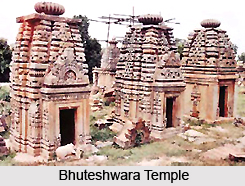 Bhuteshwara Temple is one of the principal temples in the locality of Naran Nag, dedicated to Lord Shiva. Also referred to as Nandikshetra or Nandisakshetra, this is a 12th century temple built by King Jayasimha. The mountain spur that extends southeast from Harmukh Mountain denotes the residence of Bhuteshwara. Built using grayish granite, the temple has a dome-shaped ceiling.
Bhuteshwara Temple is one of the principal temples in the locality of Naran Nag, dedicated to Lord Shiva. Also referred to as Nandikshetra or Nandisakshetra, this is a 12th century temple built by King Jayasimha. The mountain spur that extends southeast from Harmukh Mountain denotes the residence of Bhuteshwara. Built using grayish granite, the temple has a dome-shaped ceiling.
Bhuteshwara temple has a gigantic rectangular stonewall with a two-chambered gateway. There are two small shrines to the south of the main temple. The distinctiveness of one of them lies in the fact that it is a colossal rectangular stone depression carved out of a single gigantic block of granite. To the northwestern corner of the colonnade, there is a large spring formed by the fresh water that trickles out of the mountainside. Due to age and neglect, however the Bhuteshwara shrine is now almost in a decrepit state. The temple is accessible from Srinagar city, with Jammu Tawi Railway Station serving as the nearest railhead.
This article is a stub. You can enrich by adding more information to it. Send your Write Up to content@indianetzone.com





















